A Guide to Reykjavík's Iconic Harpa
Exploring Iceland's Best Concert Hall and an Architectural Gem
March 11, 2024
A Guide to Reykjavík's Iconic Harpa
Exploring Iceland's Best Concert Hall and an Architectural Gem
March 11, 2024
Harpa Concert Hall is a testament to Iceland’s love affair with the arts and its commitment to cutting-edge design. Harpa is not just a venue for world-class musical and theatre performances; it’s a hub of Icelandic culture and a must-see on any Reykjavík tour for architecture enthusiasts.
The Architectural Feat of Harpa
Harpa’s design is a collaboration between Danish firm Henning Larsen Architects and Icelandic/Danish artist Olafur Eliasson. It is made up of geometric glass structures that mirrors the rocky basalt landscape of Iceland. The building’s south-facing façade comprises thousands of glass panels arranged in a quasi-brick pattern.
These panels, each uniquely shaped and coloured, mimic the basalt landscapes of Iceland while capturing and refracting the light in a kaleidoscope of colours. This design creates a mesmerising visual experience and plays a significant role in the building’s energy efficiency, capturing sunlight to warm the interiors during colder months.
History of Harpa
The concert hall’s journey began in 2007, with its opening in May 2011, during a period of economic uncertainty in Iceland. sts to its doors. It is named after the old Norse word for ‘harp’, a nod to its musical roots. The construction of Harpa was not without its challenges.
Initiated just before the 2008 financial crisis, the project faced significant financial hurdles that threatened its completion. However, the Icelandic government and the people’s commitment to culture and arts paved the way for Harpa’s completion. It stands today as a symbol of resilience and innovation.
The use of local materials and expertise played a crucial role in Harpa’s construction, minimising its environmental impact and supporting the local economy. The building’s sustainable features, such as geothermal heating and natural light optimisation, exemplify Iceland’s leadership in environmental consciousness.
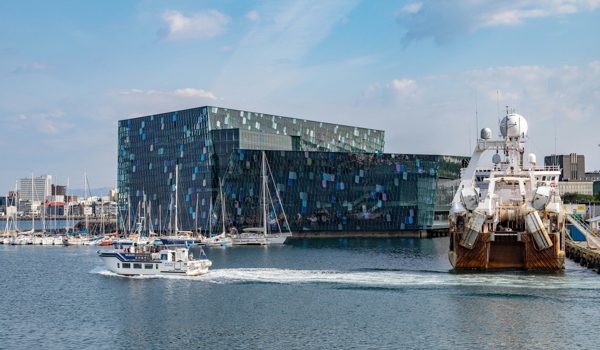
Hosting Local Artists and the World on a Stage
Harpa’s world-class acoustics and award-winner design were designed to host a wide array of performances from opera to orchestral concerts and jazz shows to rock gigs. The main concert hall, Eldborg, is a marvel of acoustic design. Its adjustable reverberation chambers and state-of-the-art sound diffusion systems ensure pristine sound quality for any performance.
Harpa is the home of the Iceland Symphony Orchestra and The Icelandic Opera, offering a rich calendar of events ranging from classical music to rock concerts. It’s also a venue that has hosted local artists like Björk, Sigur Rós, and Laufey.
Culinary and Shopping Experience
In addition to concerts, theatre productions and local events, Harpa is a destination for dining and shopping. Eateries include a high-end restaurant and a casual café; there’s something for everyone. The on-site shops offer Icelandic design items and souvenirs, making Harpa a place where culture, commerce, and cuisine intersect.
Family-Friendly: Activities for All Ages
Harpa is a Reykjavík attraction accessible to everyone, including families with children. With interactive music workshops, family concerts, and educational tours that explore the building’s unique architecture and environmental features, Harpa offers something for every age. Children can experience the joy of music and art in a fun and engaging way.
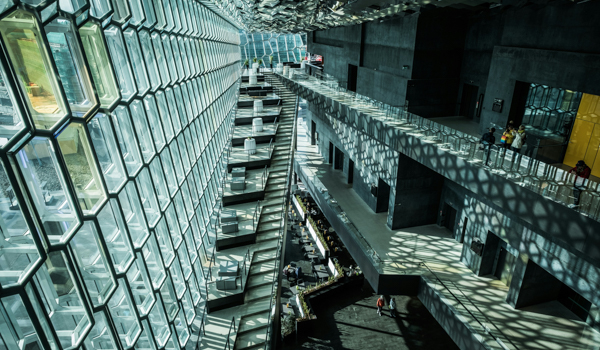
Surrounded by Wonders: Attractions Nearby
The area around Harpa is brimming with attractions. Just a stone’s throw away, you’ll find the Old Harbour, teeming with life and activities, from whale watching tours to cosy cafés and boutiques. The Sun Voyager sculpture, a beautiful ode to the Viking spirit, offers a perfect photo op against the backdrop of Mount Esja. For a taste of Reykjavik’s history and culture, the nearby National Gallery of Iceland and the Reykjavik Art Museum are not to be missed.
A Must-Visit on Your Reykjavík Adventure
Visiting Harpa is an opportunity to experience the soul of Iceland. It’s a place where the natural and cultural elements of Icelandic identity are celebrated and shared, not just with locals but with the world. The building is a symbol of innovation and creativity, reflecting the country’s commitment to art and culture. For families, it’s a welcoming space that offers educational and entertaining experiences, fostering a love for music and art in the next generation.
A Guide to Perlan Museum in Reykjavík
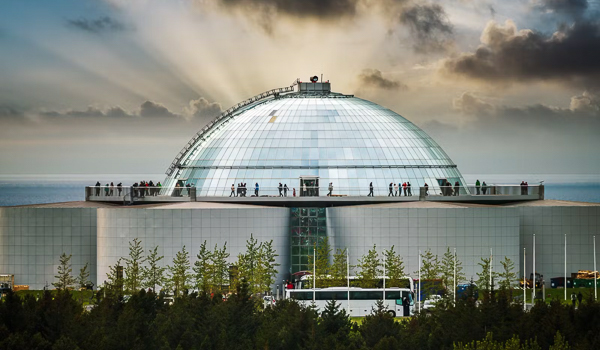
When visiting Reykjavík, there are a few must-see attractions for culture and architecture lovers. One of them is Perlan, a fascinating museum that provides exhibits on the natural wonders of Iceland and offers breathtaking panoramic views of Reykjavík and beyond from its famed observation deck.
Find out more about the museum in our guide to Perlan.
Tours to Harpa
Reykjavík tours include a stop at Harpa, including the hop-on hop-off tour, which also visits museums, Hallgrímskirkja and other Reykjavík highlights. There are also walking tours available that include a visit to Harpa, and food walks that stop by the concert hall to taste some local delicacies at Harpa’s eateries.
Opening Hours and Accessibility
Harpa welcomes visitors every day, and the general opening hours are from morning until late evening, which extends further on event nights. Detailed opening hours can be found on Harpa’s official website.
In terms of accessibility, Harpa prides itself on being inclusive. Wheelchair access is available throughout the building, with elevators and accessible restrooms ensuring that everyone can enjoy and feel comfortable in the hall.
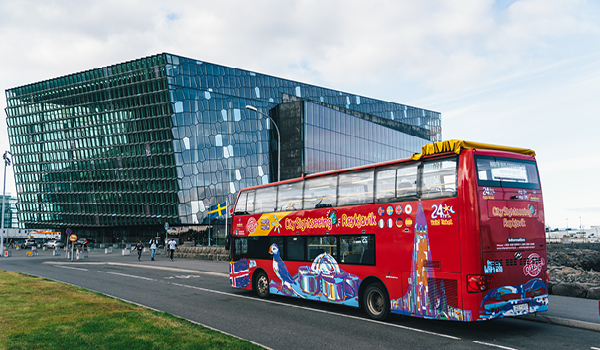
Parking and Transportation
Harpa has its own underground parking facility, providing convenience to those driving. It’s also well-connected by public transportation, with several bus lines stopping nearby. For those preferring to walk, Harpa’s central location makes it a comfortable stroll from many of Reykjavik’s key points of interest.
Proximity to Other Attractions
Harpa’s presence on Reykjavik’s waterfront places it within easy reach of other attractions. It’s a short walk to the Old Harbour, which is the starting point for whale-watching tours. The Sun Voyager sculpture, a representation of a Viking ship, is also nearby, offering a perfect photo opportunity against the backdrop of the majestic Mount Esja.
Harpa is where the heart of Iceland’s cultural scene beats the strongest, all housed in a building that is as much a work of art as the performances it holds within. Whether you’re there to enjoy the melodies of a symphony, appreciate the cutting-edge Nordic design, taste the local cuisine, or simply shop for unique Icelandic goods, Harpa offers an unmissable experience.
A Visitor's Guide to Hallgrímskirkja

Hallgrímskirkja is probably the most important stop on any Reykjavík city sightseeing tour. If you have time to visit only one site in Reykjavík, make sure it's Hallgrímskirkja.
Read out article about Iceland's most iconic church..
More Than Just a Concert Hall
Beyond its architectural and acoustic feats, Harpa serves as a beacon of culture, hosting an array of events, from international conferences to local art exhibitions. Its open spaces, including the ground floor’s public square, invite locals and tourists alike to gather, explore, and be inspired. Harpa’s significance extends beyond its physical boundaries, contributing to Reykjavik’s cultural landscape and the global art scene.
For anyone embarking on an Icelandic adventure, a visit to Harpa is a must. It’s a place where you can witness the interplay of light, sound, and architecture, a reminder of the beauty that human ingenuity can create when inspired by the natural world.
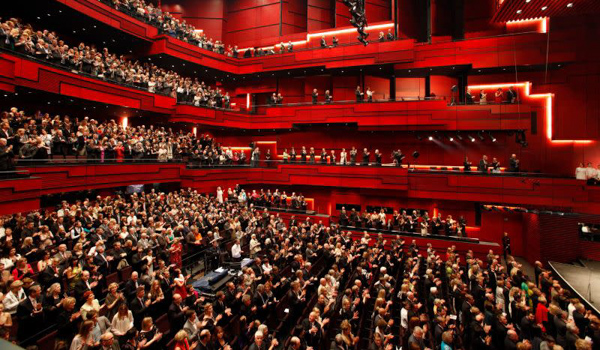
Questions and Answers about Harpa Concert Hall in Reykjavík
Can you go inside Harpa concert hall? You can go inside Harpa Concert Hall to explore its public spaces, dine, shop, attend events, or participate in guided tours.
Who built Harpa? Harpa was built by the Icelandic government and the City of Reykjavik. Construction began in 2007 and was completed in 2011.
Where is the biggest music venue in Iceland? The biggest music venue in Iceland is Harpa Concert Hall. There is another concert hall in the north Iceland town of Akureyri called Hof.
What makes Harpa an iconic building in Reykjavík? Harpa is iconic due to its unique glass facade designed by Olafur Eliasson and Henning Larsen Architects, which reflects the surrounding sea and sky. It’s also the home of the Icelandic Symphony Orchestra.
When was Harpa built? Work on Harpa began in 2007 and was officially opened in May 2011.
Who designed Harpa concert hall? Harpa Concert Hall was designed by the Danish firm Henning Larsen Architects and Icelandic/Danish artist Ólafur Eliasson.
What is the Harpa concert hall made of? Harpa is made of a steel framework clad with geometric-shaped glass panels of varying colours.
How much did it cost to build Harpa? The cost to build Harpa was approximately 164 million Euros and took four years to complete.
What does Harpa mean in Icelandic? In Icelandic, “Harpa” refers to a time of year (spring month) and is also a historical name for the harp, an instrument.
Are guided tours available for Harpa Concert Hall? Guided tours are available, offering insights into its architecture, history, and operations. For the most recent information, please visit Harpa’s website.
Can Harpa be visited as part of a Reykjavík city tour? Harpa can indeed be visited as part of a Reykjavík city tour, with many tours including it as a key point of interest, including the hop-on hop-off tour.
How can I get tickets for events at Harpa? Tickets for events at Harpa can be purchased through its official website, the box office, or authorised ticketing partners.
What dining options are available inside Harpa? Dining options inside Harpa include fine dining restaurants and a casual café, offering a mix of Icelandic cuisine and international dishes.
What facilities are available for visitors with disabilities at Harpa? Facilities for visitors with disabilities at Harpa include wheelchair access, accessible restrooms, and hearing loop systems in the concert halls.
What are the best photo spots in and around Harpa? The best photo spots in and around Harpa include its striking facade, the grand foyer with its reflective glass, and the views of Reykjavik harbour from its windows.
What are the nearby attractions to Harpa? Nearby attractions to Harpa include the Old Harbour, the Sun Voyager sculpture, and the downtown area with its shops, restaurants, and museums.
The best tours in Iceland
There’s so much to discover on your visit to Iceland—and it’s not all on the south coast. With cultural sights in the capital of Reykjavik to spa visits and wildlife tours, a trip to Iceland promises an action-packed experience.
For example, take a trip to one of Iceland’s most relaxing spa locations. The Blue Lagoon, Iceland’s most famous, offers the opportunity to dip in the milky waters known for their therapeutic benefit. Alternatively, there’s the Sky Lagoon, with its immense views over the Atlantic.
Of course, if you’re coming in winter, don’t miss a trip to see the northern lights. This dancing display in the night sky is truly an unforgettable experience.
Find out more in our guide to the best tours in Iceland.
Tours in the spotlight
4 Tours
REYKJAVIK EXCURSIONS BLOG
Get inspired! Information and tips and must see places in Iceland, fun facts, customs and more.
The Silver Circle of West Iceland - Your Guide
You’ve heard of the Golden Circle, but here’s why you should head to Iceland’s western region to explore the msytical Silver Circle tour route.
Read BlogA Guide to Reykjavík's Iconic Harpa
Exploring Iceland's Best Concert Hall and an Architectural Gem
March 11, 2024
A Guide to Reykjavík's Iconic Harpa
Exploring Iceland's Best Concert Hall and an Architectural Gem
March 11, 2024
Harpa Concert Hall is a testament to Iceland’s love affair with the arts and its commitment to cutting-edge design. Harpa is not just a venue for world-class musical and theatre performances; it’s a hub of Icelandic culture and a must-see on any Reykjavík tour for architecture enthusiasts.
The Architectural Feat of Harpa
Harpa’s design is a collaboration between Danish firm Henning Larsen Architects and Icelandic/Danish artist Olafur Eliasson. It is made up of geometric glass structures that mirrors the rocky basalt landscape of Iceland. The building’s south-facing façade comprises thousands of glass panels arranged in a quasi-brick pattern.
These panels, each uniquely shaped and coloured, mimic the basalt landscapes of Iceland while capturing and refracting the light in a kaleidoscope of colours. This design creates a mesmerising visual experience and plays a significant role in the building’s energy efficiency, capturing sunlight to warm the interiors during colder months.
History of Harpa
The concert hall’s journey began in 2007, with its opening in May 2011, during a period of economic uncertainty in Iceland. sts to its doors. It is named after the old Norse word for ‘harp’, a nod to its musical roots. The construction of Harpa was not without its challenges.
Initiated just before the 2008 financial crisis, the project faced significant financial hurdles that threatened its completion. However, the Icelandic government and the people’s commitment to culture and arts paved the way for Harpa’s completion. It stands today as a symbol of resilience and innovation.
The use of local materials and expertise played a crucial role in Harpa’s construction, minimising its environmental impact and supporting the local economy. The building’s sustainable features, such as geothermal heating and natural light optimisation, exemplify Iceland’s leadership in environmental consciousness.

Hosting Local Artists and the World on a Stage
Harpa’s world-class acoustics and award-winner design were designed to host a wide array of performances from opera to orchestral concerts and jazz shows to rock gigs. The main concert hall, Eldborg, is a marvel of acoustic design. Its adjustable reverberation chambers and state-of-the-art sound diffusion systems ensure pristine sound quality for any performance.
Harpa is the home of the Iceland Symphony Orchestra and The Icelandic Opera, offering a rich calendar of events ranging from classical music to rock concerts. It’s also a venue that has hosted local artists like Björk, Sigur Rós, and Laufey.
Culinary and Shopping Experience
In addition to concerts, theatre productions and local events, Harpa is a destination for dining and shopping. Eateries include a high-end restaurant and a casual café; there’s something for everyone. The on-site shops offer Icelandic design items and souvenirs, making Harpa a place where culture, commerce, and cuisine intersect.
Family-Friendly: Activities for All Ages
Harpa is a Reykjavík attraction accessible to everyone, including families with children. With interactive music workshops, family concerts, and educational tours that explore the building’s unique architecture and environmental features, Harpa offers something for every age. Children can experience the joy of music and art in a fun and engaging way.

Surrounded by Wonders: Attractions Nearby
The area around Harpa is brimming with attractions. Just a stone’s throw away, you’ll find the Old Harbour, teeming with life and activities, from whale watching tours to cosy cafés and boutiques. The Sun Voyager sculpture, a beautiful ode to the Viking spirit, offers a perfect photo op against the backdrop of Mount Esja. For a taste of Reykjavik’s history and culture, the nearby National Gallery of Iceland and the Reykjavik Art Museum are not to be missed.
A Must-Visit on Your Reykjavík Adventure
Visiting Harpa is an opportunity to experience the soul of Iceland. It’s a place where the natural and cultural elements of Icelandic identity are celebrated and shared, not just with locals but with the world. The building is a symbol of innovation and creativity, reflecting the country’s commitment to art and culture. For families, it’s a welcoming space that offers educational and entertaining experiences, fostering a love for music and art in the next generation.
A Guide to Perlan Museum in Reykjavík

When visiting Reykjavík, there are a few must-see attractions for culture and architecture lovers. One of them is Perlan, a fascinating museum that provides exhibits on the natural wonders of Iceland and offers breathtaking panoramic views of Reykjavík and beyond from its famed observation deck.
Find out more about the museum in our guide to Perlan.
Tours to Harpa
Reykjavík tours include a stop at Harpa, including the hop-on hop-off tour, which also visits museums, Hallgrímskirkja and other Reykjavík highlights. There are also walking tours available that include a visit to Harpa, and food walks that stop by the concert hall to taste some local delicacies at Harpa’s eateries.
Opening Hours and Accessibility
Harpa welcomes visitors every day, and the general opening hours are from morning until late evening, which extends further on event nights. Detailed opening hours can be found on Harpa’s official website.
In terms of accessibility, Harpa prides itself on being inclusive. Wheelchair access is available throughout the building, with elevators and accessible restrooms ensuring that everyone can enjoy and feel comfortable in the hall.

Parking and Transportation
Harpa has its own underground parking facility, providing convenience to those driving. It’s also well-connected by public transportation, with several bus lines stopping nearby. For those preferring to walk, Harpa’s central location makes it a comfortable stroll from many of Reykjavik’s key points of interest.
Proximity to Other Attractions
Harpa’s presence on Reykjavik’s waterfront places it within easy reach of other attractions. It’s a short walk to the Old Harbour, which is the starting point for whale-watching tours. The Sun Voyager sculpture, a representation of a Viking ship, is also nearby, offering a perfect photo opportunity against the backdrop of the majestic Mount Esja.
Harpa is where the heart of Iceland’s cultural scene beats the strongest, all housed in a building that is as much a work of art as the performances it holds within. Whether you’re there to enjoy the melodies of a symphony, appreciate the cutting-edge Nordic design, taste the local cuisine, or simply shop for unique Icelandic goods, Harpa offers an unmissable experience.
A Visitor's Guide to Hallgrímskirkja

Hallgrímskirkja is probably the most important stop on any Reykjavík city sightseeing tour. If you have time to visit only one site in Reykjavík, make sure it's Hallgrímskirkja.
Read out article about Iceland's most iconic church..
More Than Just a Concert Hall
Beyond its architectural and acoustic feats, Harpa serves as a beacon of culture, hosting an array of events, from international conferences to local art exhibitions. Its open spaces, including the ground floor’s public square, invite locals and tourists alike to gather, explore, and be inspired. Harpa’s significance extends beyond its physical boundaries, contributing to Reykjavik’s cultural landscape and the global art scene.
For anyone embarking on an Icelandic adventure, a visit to Harpa is a must. It’s a place where you can witness the interplay of light, sound, and architecture, a reminder of the beauty that human ingenuity can create when inspired by the natural world.

Questions and Answers about Harpa Concert Hall in Reykjavík
Can you go inside Harpa concert hall? You can go inside Harpa Concert Hall to explore its public spaces, dine, shop, attend events, or participate in guided tours.
Who built Harpa? Harpa was built by the Icelandic government and the City of Reykjavik. Construction began in 2007 and was completed in 2011.
Where is the biggest music venue in Iceland? The biggest music venue in Iceland is Harpa Concert Hall. There is another concert hall in the north Iceland town of Akureyri called Hof.
What makes Harpa an iconic building in Reykjavík? Harpa is iconic due to its unique glass facade designed by Olafur Eliasson and Henning Larsen Architects, which reflects the surrounding sea and sky. It’s also the home of the Icelandic Symphony Orchestra.
When was Harpa built? Work on Harpa began in 2007 and was officially opened in May 2011.
Who designed Harpa concert hall? Harpa Concert Hall was designed by the Danish firm Henning Larsen Architects and Icelandic/Danish artist Ólafur Eliasson.
What is the Harpa concert hall made of? Harpa is made of a steel framework clad with geometric-shaped glass panels of varying colours.
How much did it cost to build Harpa? The cost to build Harpa was approximately 164 million Euros and took four years to complete.
What does Harpa mean in Icelandic? In Icelandic, “Harpa” refers to a time of year (spring month) and is also a historical name for the harp, an instrument.
Are guided tours available for Harpa Concert Hall? Guided tours are available, offering insights into its architecture, history, and operations. For the most recent information, please visit Harpa’s website.
Can Harpa be visited as part of a Reykjavík city tour? Harpa can indeed be visited as part of a Reykjavík city tour, with many tours including it as a key point of interest, including the hop-on hop-off tour.
How can I get tickets for events at Harpa? Tickets for events at Harpa can be purchased through its official website, the box office, or authorised ticketing partners.
What dining options are available inside Harpa? Dining options inside Harpa include fine dining restaurants and a casual café, offering a mix of Icelandic cuisine and international dishes.
What facilities are available for visitors with disabilities at Harpa? Facilities for visitors with disabilities at Harpa include wheelchair access, accessible restrooms, and hearing loop systems in the concert halls.
What are the best photo spots in and around Harpa? The best photo spots in and around Harpa include its striking facade, the grand foyer with its reflective glass, and the views of Reykjavik harbour from its windows.
What are the nearby attractions to Harpa? Nearby attractions to Harpa include the Old Harbour, the Sun Voyager sculpture, and the downtown area with its shops, restaurants, and museums.
The best tours in Iceland
There’s so much to discover on your visit to Iceland—and it’s not all on the south coast. With cultural sights in the capital of Reykjavik to spa visits and wildlife tours, a trip to Iceland promises an action-packed experience.
For example, take a trip to one of Iceland’s most relaxing spa locations. The Blue Lagoon, Iceland’s most famous, offers the opportunity to dip in the milky waters known for their therapeutic benefit. Alternatively, there’s the Sky Lagoon, with its immense views over the Atlantic.
Of course, if you’re coming in winter, don’t miss a trip to see the northern lights. This dancing display in the night sky is truly an unforgettable experience.
Find out more in our guide to the best tours in Iceland.
Tours in the spotlight
4 Tours
REYKJAVIK EXCURSIONS BLOG
Get inspired! Information and tips and must see places in Iceland, fun facts, customs and more.
The Silver Circle of West Iceland - Your Guide
You’ve heard of the Golden Circle, but here’s why you should head to Iceland’s western region to explore the msytical Silver Circle tour route.
Read Blog